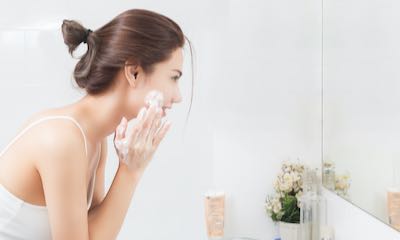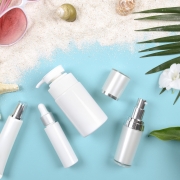Scrub to Shine: Your Guide to Exfoliation
Look in the mirror and you see dead skin. Don’t be shocked. Your body needs it to be that way. All the skin cells that interact with the world are dead by design. This layer protects you. But if it doesn’t move over for more freshly deceased cells to pop to the top, it could be time to exfoliate.
What is Exfoliation?
The simple definition for exfoliation is clearing away excess dead cells on the surface of your skin.
“Out with the old and in with the new” is the principle behind exfoliating. Remove the older cells to make room for newer, fresher skin.
Why You Should Exfoliate
You might want to understand more about exfoliating before you start scrubbing, peeling, or otherwise expelling the top layer of your skin. The practice of exfoliation comes from the knowledge of how your skin cells grow and replenish.
Cells are born deep in your skin, and they’re pushed to the surface by the growth of new cells. By the time they reach the surface, your skin cells have died. But they shingle together to help create a protective barrier before eventually being shed completely.
Exfoliation speeds up the shedding. And it helps you avoid buildup of stubborn dead skin cells that can impact your skin’s appearance. If you’re seeing dry patches or dealing with flaky areas, exfoliating could be for you.
Additional benefits of exfoliation include:
- helping skin appear brighter
- aiding in the absorption of your skincare products so they work better
- assisting in keeping breakouts at bay by clearing pores of dead-skin buildup
- supporting production of a key skin protein—collagen
Discover the Different Varieties of Exfoliation
Picking a way to expunge the outermost layer of your skin may sound like choosing your preferred version of torture. But exfoliation shouldn’t be painful. Whether you choose a mechanical or chemical means—the two main types of exfoliating—you’ll have plenty of pain-free options.
Mechanical exfoliation (sometimes also called physical exfoliation) isn’t the most comforting term. But it just means using the force of friction to remove dead skin. That encompasses a lot of options:
- light buffing with a washcloth
- grainy sugar polish or other gentle scrub
- homemade coffee scrub
- wet pumice stone (never use a dry one on your skin)
- exfoliating glove
- brushes
- microdermabrasion
Even though you may have guessed how chemical exfoliation works, it’s not quite as harsh as it sounds. Yes, chemicals are involved. Typically, they are enzymes, retinoids, and gentle, natural acids. These compounds loosen the bonds holding skin cells together so they’re more easily removed.
Those choosing to chemically exfoliate often opt for alpha or beta hydroxy acids. Popular alpha hydroxy acids are water soluble and similar to the acid found in citrus fruit, apples, grapes, and yogurt. Beta hydroxy acids are often used as treatments for skin issues. But these oil-soluble acids (like salicylic acid) are also exfoliant options.
Enzymes provide a more ancient approach that started with putting fruit on the skin. Even today, the enzymes used in chemical exfoliation also come from fruits and vegetables. These enzymes work on skin proteins, breaking them down to eliminate dead-skin buildup.
Retinoids (commonly found in plant pigments) are more modern, and they’re commonly used as medication. These compounds come from the antioxidant vitamin A.
You have your choice of over-the-counter options for chemical exfoliation. Choose wisely, with your skin type and goals in mind. You should consult your dermatologist or healthcare provider before starting a new exfoliation practice.
How to Exfoliate for Your Skin Type
Just like your cleanser, moisturizer, and other skincare products, the exfoliation tactic you choose depends on skin type. If you don’t know it, take this skin type quiz to find out where you fall on the spectrum.
Removing your outside layer of skin is an inherently irritating process. So, your skin type should guide the form and frequency of your exfoliation experience. Sensitive, dry, oily, and combination skin all tolerate exfoliating differently.
Here’s what you need to know before you choose an exfoliating method:
- Sensitive Skin Type: Exfoliate gently and less frequently to minimize the redness and stinging that comes easily for this type. A very mild scrub or a simple washcloth may be all the mechanical exfoliating your skin can tolerate. And mild hydroxy acids and enzymes are your best bet for chemical exfoliating.
- Dry Skin Type: Like those with sensitive skin, care should be taken to minimize over-exfoliating. Gentle is also the standard for mechanical or chemical exfoliant methods. But the flakes and rough buildup of dry skin does require regular exfoliating to keep those issues at bay and maximize your skincare products’ effectiveness.
- Oily Skin Type: Exfoliate away. This type tolerates more robust approaches to chemical and mechanical exfoliation. Tools like brushes and pumice stones, along with rougher scrubs, are great for oily skin. Stronger chemical peels are also options for this skin type. And exfoliating more frequently isn’t off the table like those with dry or sensitive skin.
- Combination Skin Type: You have two skin types to deal with, so exfoliate them separately. Be gentle with the dry sections and stronger on the oily parts.
Your skin will tell you if you’re exfoliating too often or taking an approach that’s too harsh. Pay attention to what the color and feel of your skin is telling you. Exfoliating improperly or too often can cause problems for your skin. Watch for redness, small breakouts, and unusual sensitivity to your normal skincare products.
Help Reveal a New Shine for Your Skin
Taking care of your skin sometimes means shedding some of it. Properly exfoliating one to three times per week (depending on skin type) is the best way to scrub or peel away the buildup of dead skin to help you shine. Just remember to consider the proper approach for your skin and always follow-up with an appropriate moisturizer. And like with your overall health, listen to what your body is telling you. The good news is that the results of your exfoliating efforts should be obvious—and written all over your face.
References
https://www.aad.org/skin-care-secrets/safely-exfoliate-at-home
https://www.sciencedirect.com/science/article/abs/pii/S0029646507000266
https://onlinelibrary.wiley.com/doi/abs/10.1002/9781118655566.ch56
https://www.dermascope.com/skin-care/10296-alpha-beta-enzymes-the-science-of-chemical-exfoliation
https://hbmag.com/exfoliation/
https://www.healthline.com/health/beauty-skin-care/meaning-of-exfoliating
https://www.healthline.com/health/beauty-skin-care/over-exfoliating
https://www.dermascope.com/exfoliation/9935-what-is-physical-exfoliation



















